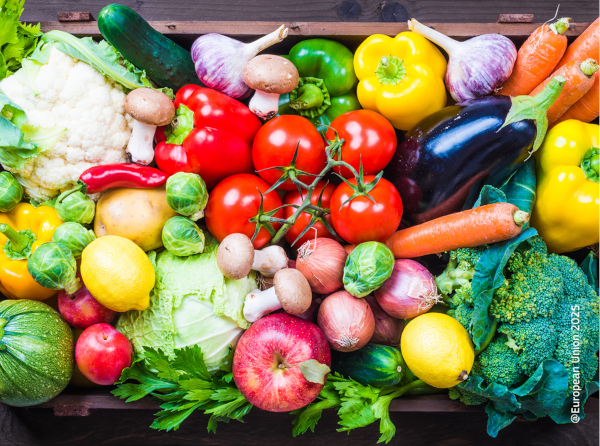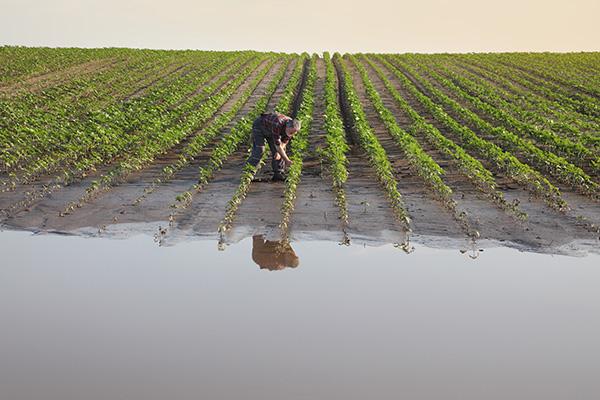Fruit and vegetables in the EU
In 2023, fruit and vegetables remained a key sector in European agriculture, accounting for 12.6% or EUR 68 billion of total EU agricultural production. The EU produced 59.8 million tonnes of vegetable, including pulses and 41.2 million tonnes of fruits and nuts.
The EU is one of the world’s leading producers of fruit and vegetables. It supplies both fresh and processed markets, ensuring high-quality produce reaches consumers across the EU and beyond.

This report provides a comprehensive overview of global and EU fruit and vegetable production. The first section highlights worldwide trends, followed by a more detailed analysis of the EU as a whole and its 27 EU countries.
Find out which fruits and vegetables are most commonly produced worldwide, in the EU, and in each EU member.
Sector organisations
The production of fruit and vegetables is highly fragmentated, with the average size for orchard farms of 2.5 hectares (ha) in 2022 and 2.7 ha for vegetables farms according to Eurostat.
At the same time, fruit and vegetables are highly perishable. This puts producers in a permanent weak bargaining position in the supply chain. Producer organisations (POs) were therefore established as a policy instrument in the fruit and vegetables sector and have been at the heart of the EU fruit and vegetables policy since its introduction in the early 1970’s.
The role of producer organisations in strengthening farmers’ market position
POs are created on the initiative of producers on a voluntary basis and are also controlled by producers. Their aim is to:
- concentrate the supply,
- place on the market the products of its members,
- strengthen the bargaining power of fruit and vegetables producers and
- foster a fairer distribution of added value along the supply chain.
To be recognised as a PO in the fruit and vegetables sector, the organisation must meet certain requirements and respect national legal and administrative structures (Commission Delegated Regulation (EU) 2017/891), which include:
- determining a minimum number of members,
- abiding by the minimum length of membership,
- having at its disposal structures necessary to ensure their functioning and to delivering various services for its members, and
- deciding on the products covered.
Recognised POs, may plan production, optimise the production costs, place on the market and negotiate contracts for the supply of agricultural products, on behalf of their members, for all or part of their total production. They can be involved in both fresh and processed sectors.
The number of organisations differs between EU countries, with some countries having many recognised POs, while others few or none. Differences also exist on the share of production of fruit and vegetables marketed through the POs.
Associations of producer organisations
POs may come together in an association of producer organisations. EU countries may, on request, recognise associations of producer organisations in a given sector.
Transnational association of producer organisations refers to any association of producer organisations in which at least one of the associated organisations is located in a country member other than where the association has its head office.
Interbranch organisations
An interbranch organisations gathers representatives of economic activities linked to the production and to at least one supply chain stage, in one or more sectors. Interbranch organisations can play an important part in allowing dialogue between actors in the supply chain, and in promoting best practices and market transparency.
Recognition of interbranch organisations is also favoured where there proves to be sufficient representatives of the various occupational categories in the fruit and vegetables sector and carry out practical actions contributing to the goals of the scheme.
Related links
Fruit and vegetables sector reports
Producer and interbranch organisations
Fruit and vegetables in the CAP
CAP Strategic Plans
EU countries’ CAP Strategic Plans outline the strategic approach and targeting of support for recognised producer organisations.
A considerable range of types of interventions is available for fruit and vegetables producers to contribute to the development of their economic viability and competitiveness in line with environmental and social sustainability goals.
In their CAP Strategic Plans, EU countries may support the sector mainly through designated sectorial interventions for fruit and vegetables. These sectorial interventions are implemented by recognised POs through their operational programmes, which:
- allow producers to reflect together on the right collective business strategy to deploy;
- ensure they are not only suitable for their needs but also support actions that help adapt to climate change and put in place systems for a better management and prevention of climate risks;
- help POs implement approaches that contribute to improve quality, reduce costs and meet the sustainability requirements of the consumers.
To implement their operational programme, POs should achieve a minimum value of marketed production, laid down by the EU member. This is to ensure that the support received is effective. The implementation of the operational programme is financed through the operational fund, to gather contributions of producer members or the PO itself, and EU financial assistance.
CAP Strategic Plans catalogue of interventions
In addition, the fruit and vegetables producers may also benefit from various interventions in the CAP Strategic Plans. EU countries may plan interventions, such as:
Through these interventions, fruit and vegetables producers may receive support for investments in hail protection, irrigation systems, risk management and knowledge transfer. The catalogue of CAP interventions lists the actions EU countries can implement as part of their CAP Strategic Plans.
Promotion of fruit and vegetables

Through the EU promotion policy, the Commission helps EU fruit and vegetables producers to sell their agricultural products. The aim is to increase the consumption of fresh fruit and vegetables from the EU by informing consumers about a balanced and healthy diet.
The Enjoy, it's from Europe! portal aims to raise awareness of all the initiatives the Commission co-finances or directly organises to promote the great variety of EU agricultural produce.
School scheme
To encourage the consumption of fruit and vegetables by school children, the EU supports the supply of fruit and vegetables in educational establishments.
Related links
Sustainability and climate change
Fruit and vegetables producers are amongst the first to see the effects of climate change, despite increasing their efforts to adapt to it. For example, fruit and vegetables producers can:
- improve management of permanent crops, to maximise the removal and carbons sequestration, for example covering the rows between trees, use of plant protective trees in the field borders, etc.;
- implement on-farm energy installation, which is compatible with orchards, such as solar panel above the trees;
- improve energy efficiency in post-harvest processes (modernisation of storage facilities, improvement of isolation, etc.) and waste management;
- improve greenhouses with more energy efficient lightning and heating/cooling, etc.;
- improve soil management practices to protect carbon in soils, with interrow cover, zero tillage, etc.).
Each PO in the fruit and vegetables sector must ensure that at least 15% of the total expenditure of their operational programme is dedicated to agri-environment-climate objectives.
Related links
Market monitoring
The European Commission has set up market observatories made up of experts in the field of topic from various EU countries. Market observatories offer the possibility to exchange the latest information on the market situation, share the knowledge and to address various topics related to the sector.
In the fruit and vegetables sector, the following market observatories are held regularly:
The Commission also monitors the prices of fruit and vegetables along the supply chain, from farmgate, to ex-packaging station to retail buying and retail selling, strengthening the transparency of the transmission of value in the supply chain.
The agri-food data portal displays prices for apples, oranges, peaches and nectarines, tomatoes, bananas and potatoes at various stages of the supply chain.
Marketing standards and conformity checks
Marketing standards
Marketing standards ensure that fruit and vegetables products intended to be sold fresh to consumers may only be marketed when they are of sound, fair and marketable quality and the country of origin is indicated.
Conformity with marketing standards is required at all stages of marketing of fresh fruits and vegetables, including import, export and retail sales, with exceptions and exemptions in a few cases (direct deliveries by producers, local markets, donation, intended for processing), as defined in Commission Delegated Regulation (EU) 2023/2429.
There are 11 specific marketing standards, applied to the following fruits and vegetables:
- apples,
- citrus fruit,
- kiwifruit,
- lettuces, curled-leaved and broad-leaved endives,
- peaches and nectarines,
- pears,
- strawberries,
- sweet peppers,
- table grapes,
- tomatoes,
- bananas.
UNECE has developed over 60 specific marketing standards for fresh fruit and vegetables.
Specific EU marketing standards for individual products must be in line with the relevant UNECE standards, as per Commission Delegated Regulation (EU) 2023/2429, article 5(1)(b) and are updated regularly to this effect.
Conformity checks
Every EU country is required to set up a database of traders that market fresh fruit and vegetables covered by marketing standards, as defined by Commission Implementing Regulation (EU) 2023/2430.
The national authorities must ensure that checks are carried out selectively, based on risk analysis and with appropriate frequency, to ensure compliance with the standards and other statutory requirements for marketing fruit and vegetables.
The risk analysis must be based on the information recorded in the trader’s database. National authorities must lay down in advance which criteria they will use to determine the risk of non-compliance for a batch of produce.
Based on a risk analysis, the authorities may choose not to selectively check products not covered by a specific marketing standard (i.e. are covered by the general standard or a UNECE standard). Every EU country is required to notify the details of the coordinating authorities and inspection bodies that are in charge of the compliance checks.
Approved non-EU country
Any country exporting to the EU that has performed its own compliance checks may ask the European Commission to assess whether that system of checks meets the specific EU marketing standards, or at least equivalent standards.
The country may be granted "approved" status for some products originating on its territory that have passed these checks. The European Commission may suspend approval if it finds that, in a significant number of batches and quantities, the products don't comply with the rules.
The Commission publishes information relating to conformity checks in non-EU countries.
Exceptional measures for crisis
The production of fruit and vegetables is unpredictable, while the perishability of the fruits limits the possibilities for storage. Even limited surpluses can significantly disturb the market. Therefore, measures for crisis management are established and continue to be integrated into operational programmes of POs. Examples of measures are market withdrawals, green harvesting and non-harvesting measures, harvest insurance and support for replanting orchards.
Exceptional measures are used when a crisis or the threat of a crisis arises, and a specific response is needed to prevent a sudden drop in prices and/or mitigate its consequences. They allow the Commission to quickly take proportionate action if there is:
- a period of severe imbalance in markets;
- a loss of consumer confidence due to public, animal or plant health risks;
- a specific problem.
An agricultural reserve with a yearly allocation is established to finance these exceptional measures.

- News article
The EU’s exceptional measures for the agriculture sector have been effective in tackling multifaceted crises and in supporting farmers.
Legal basis
Basic regulation
Regulation (EU) 1308/2013 – establishing a common organisation of the markets in agricultural products.
Implementing regulations
Commission Implementing Regulation (EU) 2017/892 on the rules for the application of EU regulation 1308/2013 on the fruit and vegetables and processed fruit and vegetables sectors.
Commission Implementing Regulation (EU) 2023/2430 on rules concerning checks on conformity to marketing standards for the fruit and vegetables sector, certain processed fruit and vegetable products and the bananas sector.
Commission Implementing Regulation (EU) 2017/1185 on rules for the application of Regulations (EU) No 1307/2013 and (EU) No 1308/2013 on notifications to the Commission of information and documents and amending and repealing several Commission Regulations.
Delegated regulation
Commission Delegated Regulation (EU) 2017/891 supplementing EU regulation 1308/2013 on fruit and vegetables and processed fruit and vegetables sectors and supplementing EU regulation 1306/2013 on penalties to be applied in those sectors and amending EU implementing regulation 543/2011.
Commission Delegated Regulation (EU) 2023/2429 supplementing Regulation (EU) No 1308/2013 on marketing standards for the fruit and vegetables sector, certain processed fruit and vegetable products and the bananas sector, and repealing Commission Regulation (EC) No 1666/1999 and Commission Implementing Regulations (EU) No 543/2011 and (EU) No 1333/2011.



